
What a marketing year 2014 was! I prepared a set of price projections for fall weaning prices every month, and each month’s price projections in 2014 were higher than the preceding month, except for August (Figure 1).
The 14-month trend for my monthly price projections was $9.30 per month, which turned out to be my worst set of projections ever. While my projections underestimated fall 2014 weaned calf prices, ranchers were very happy with the higher prices.
I ended up the production year with record profit calculations for my beef cow herd study in eastern Wyoming and western Nebraska. I calculated “returns to unpaid labor, management and facilities” for my ranch herd at $577 per cow. This is record-high, and compares to $175 per cow in 2013 and $106 per cow in 2012. 2014 was a great year for beef cow producers.
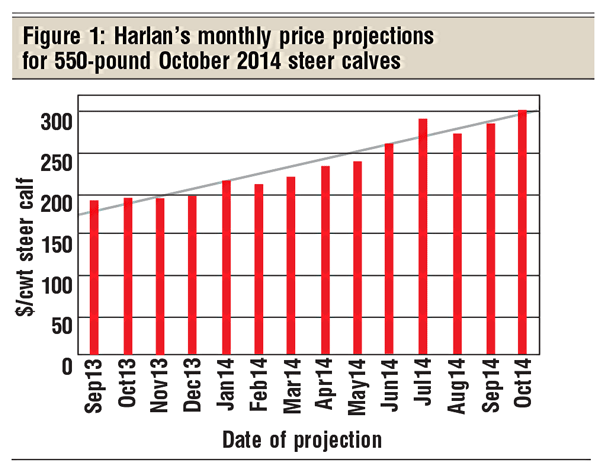
Most of the higher projected returns to the production of 2014 calves were due to the price increase for weaned calves. My calculated selling price for 569-pound weaned steer calves in mid-November 2014 was $295 per cwt. This compares to $195 per cwt in 2013 and $163 per cwt in 2012. Cull animal prices were also considerably higher in 2014.
As further confirmation of the record-high weaning prices for 2014, I will share my price analysis for mid-November 2014. I will go into some detail on this month’s price analysis to set a foundation for projecting the profits from retaining 2014 calves and selling them as backgrounded or stocker calves in early 2015.
Figure 2 presents the mid-November sale-barn prices for eastern Wyoming and western Nebraska, reported by the USDA Marketing Service.
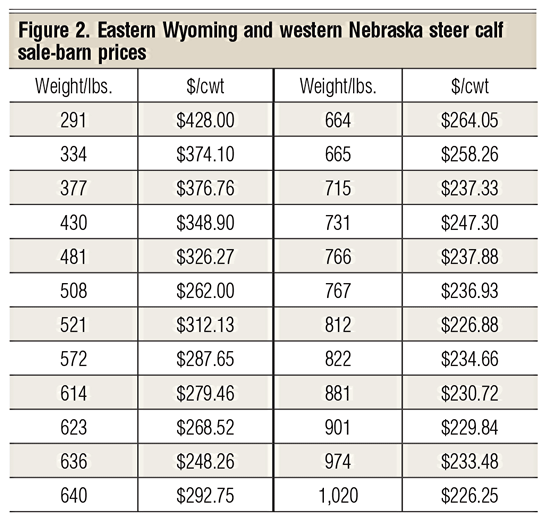
Figure 3 presents the same USDA market price data in graphic form. The variation of the dots around the trend line suggests quality variation of the calves sold. High-quality calves tend to be priced above the line, while low-quality calves tend to be priced below the line.
The calculated trend line shows the general price slide for these steer calves. The slope of the trend line gives the statistical average price slide of 26 cents per pound for this month’s steer calves. That calculates to a price slide of $26 per cwt. These are record-high calf prices and price slides.
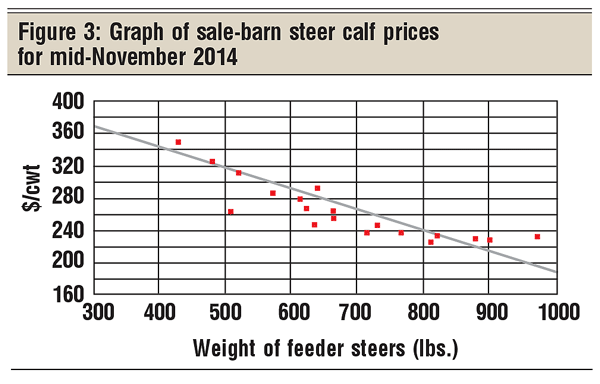
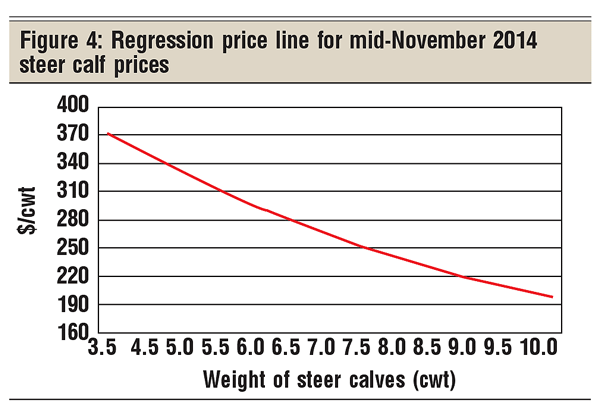
As part of my price analysis, I calculate a regression equation for each mid-month’s sale-barn prices. This equation can then be used in other spreadsheets to easily calculate the price of alternative weight steer calf prices. Figure 4 presents this regression equation in graphic form.
Figure 4 clearly illustrates the downward price slide of mid-November prices. The curvature of the line suggests that price slides aren’t constant over all steer calf weights. This price line regression is used to calculate all November 2014 steer calf prices that I use in my other marketing spreadsheets. I have a database of these monthly price line regressions back to 2004.
I like to conduct a graphic analysis of the current month’s price analysis compared to the previous month’s price analysis to see how prices are trending. Figure 5 presents this graphic analysis. In general, I conclude that steer calf prices did not change much from mid-October through mid-November 2014. Lightweight calves appeared just slightly higher in November, and heavy feeder prices were slightly lower in November. The favorable point is that steer calf prices basically did not decrease or increase in November.
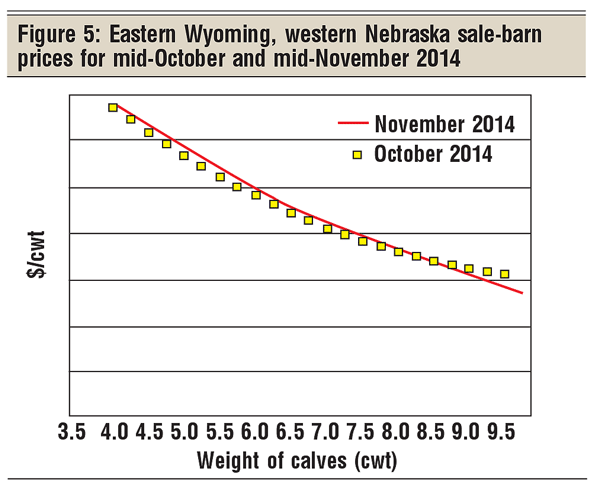
Figure 6 presents a detailed summary of eastern Wyoming and western Nebraska sale-barn prices for mid-November 2014. The top section presents the date of the market prices and the regression equation associated with that date.
 The regression equation is: Market Price = 598.6856494 + (-71.9173426 x cwt) + (3.37160578492 x cwt2). The regression equation value for a 569-pound weaned steer calf is $298.64 per cwt. The Nov14 futures contract for 750-pound feeder was $240.02 per cwt.
The regression equation is: Market Price = 598.6856494 + (-71.9173426 x cwt) + (3.37160578492 x cwt2). The regression equation value for a 569-pound weaned steer calf is $298.64 per cwt. The Nov14 futures contract for 750-pound feeder was $240.02 per cwt.
The first column in Figure 6 is calf weight in hundredweight, and the second column is the regression equation steer calf price for each respective weight of calf. The price-drop column is a statistical price-drop calculation (price slide) for each weight of steer calf. The fourth column is the total market value of the calf.
The fifth column is the value of the last pound of the calf. Remember, the value of added weight is always less than the average price of the calf. The value of the last pound should be compared to the cost of added weight when retaining calves in a grower enterprise.
The final column presents the calculated “market basis” based on “cash price minus futures price.” A market basis is calculated for each weight of steer calves in the table. The regression equation for market basis is presented along the bottom of the table.
Figure 7 gives projections for five key marketing periods in 2015: Jan15, Mar15, Spring15, Sep15 and Fall15. These periods are summarized on the figure’s right side.
I’ve also presented historical prices for these same five key marketing dates for 2012, 2013 and 2014. This will allow readers to compare annual price trends. I’m projecting fall 2015 calf prices down only slightly from fall 2014.
The bottom two lines of Figure 7 present the futures market prices for slaughter cattle. There is no “market basis” added to these slaughter cattle futures prices. Please note that these mid-November live cattle futures suggest a slight drop in slaughter cattle prices in the last half of 2015.

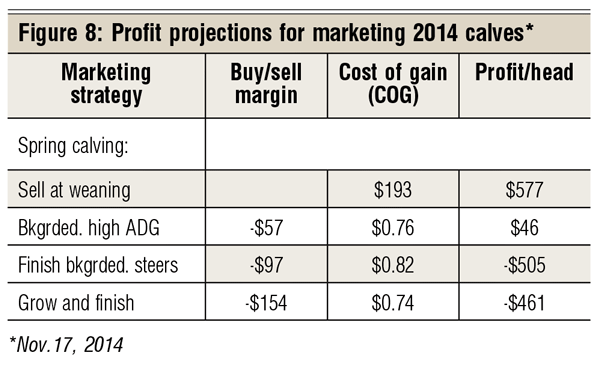
Figure 8 presents a summary of my current (mid-November) projections for the marketing of 2014 calves. I’m suggesting a record profit for beef cows selling at weaning, and $46 in added profit from backgrounding 2014 calves.
But I suggest a mixed bag for finishing cattle profits, in that I see big returns from cattle finished in November 2014. However, when you start putting 800-pound November feeders in the feedlot at $1,900-plus each, I also see some large feedlot losses for these animals at harvest (Figure 8).
These calculations are done with today’s corn futures prices. Should these projections come to attrition, feeder cattle prices could be pressured late next year. As long as cattle feeders are making a good profit feeding cattle, feeder prices will stay strong.
Harlan Hughes is a North Dakota State University professor emeritus. He lives in Kuna, Idaho. Reach him at 701-238-9607 or [email protected].
You might also like:
8 tips for being a better ranch manager in 2015
Top 20 beef industry events of 2014
How will declining fuel prices affect beef demand?
100 biggest seedstock producers in the U.S.
Bale grazing lets cows feed themselves
8 tips for being a better ranch manager in 2015
Beef cattle genomics come full circle
About the Author(s)
You May Also Like





